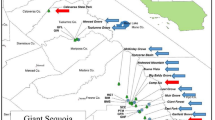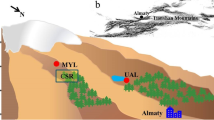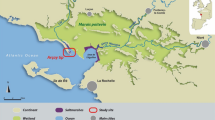Abstract
Ice floods occurring at the time of spring break-up were reconstructed for Lake Duparquet, a large unregulated water body located at the southern fringe of the boreal forest in north-western Quebec (Tardif and Bergeron 1997). Reconstruction of the frequency and magnitude of spring floods associated with ice break-up was successfully achieved using cross-dating of ice-scars occurring along the trunk of northern white-cedar (Thuja occidentalis) trees exposed to drifting ice and debris during ice break-up. Maximum ice-scar height was also used as an indicator of high lake water level. Ice-scarred trees were systematically sampled on the islands and lake shore. A total of 81 T. occidentalis trees were collected resulting in 253 cross-sections and over 2,000 dated scars associated with 616 scarring events.
Access provided by Autonomous University of Puebla. Download chapter PDF
Similar content being viewed by others
Ice floods occurring at the time of spring break-up were reconstructed for Lake Duparquet, a large unregulated water body located at the southern fringe of the boreal forest in north-western Quebec (Tardif and Bergeron 1997). Reconstruction of the frequency and magnitude of spring floods associated with ice break-up was successfully achieved using cross-dating of ice-scars occurring along the trunk of northern white-cedar (Thuja occidentalis) trees exposed to drifting ice and debris during ice break-up. Maximum ice-scar height was also used as an indicator of high lake water level. Ice-scarred trees were systematically sampled on the islands and lake shore. A total of 81 T. occidentalis trees were collected resulting in 253 cross-sections and over 2,000 dated scars associated with 616 scarring events. All scars were dated using cross-dating within (prior and after the recorded event) and among samples. The reconstruction was also recently compared with earlywood vessel anomalies occurring in tree rings from black ash (Fraxinus nigra) trees growing on the lake floodplain. It was hypothesized that earlywood vessel development would be affected in F. nigra trees exposed to floods lasting into the early growing season thus resulting in reduced cross-sectional area of the earlywood vessels. Earlywood vessels were analyzed in twenty F. nigra trees from two floodplain stands. After cross-dating, the cross-sectional area of the earlywood vessels was measured in each tree-ring using WinCell Pro Ver. 2004a (Régent Instruments Inc. 2005). In the absence of long term hydrological data for Lake Duparquet, mean monthly discharge of the unregulated Harricana River, located about 100 km to the east, was used as a proxy for the lake water level.
The ice-scar chronology revealed an increase in ice-scar frequency since about AD 1870 corresponding roughly to the end of the Little Ice Age (Fig. 1a). From 1890, ice scars were most frequent in 1934, 1936, 1939, 1947, 1956, 1967, 1976–1977, 1979–1980 and 1986 (Fig. 1a and Table 1). A comparison of both cumulative ice-scar frequency distribution and T. occidentalis age distribution indicated that they were significantly different (Fig. 1a; Kolmogorov-Smirnov test; p < 0.0001) stressing that the increase in ice-activity observed in the twentieth century is not to be associated with over sampling of younger/smaller T. occidentalis trees (Tardif and Bergeron 1997).
Thuja occidentalis ice-scar chronology for the period 1655–1990 (top figure). Values above the zero line are from visible scars and values below the zero line are from hidden scars discovered after sectioning of the trees. Both the cumulative tree age and scar distributions are also indicated. The bottom figure represents the maximum ice-scar height recorded for the same period. The years 1947 and 1979 are indicated by the gray bars (Adapted from Tardif and Bergeron 1997)
For example, only 5% of the scarring events were recorded in 1870 at a time when more than 80% of the trees were present on the lake shore (Fig. 1a). On Lake Duparquet, an increase in maximum ice-scar height was also observed during the twentieth century (Fig. 1b) with maximum height being approximately 100 cm higher than during the late part of the Little Ice Age (Tardif and Bergeron 1997). In the twentieth century high flood levels at the time of ice break-up were observed in 1922, 1947, 1959, 1976, 1979 and 1984 (Fig. 1b and Table 1). Some of these years also corresponded to years with abundant scarring events (Fig. 1a). Many of the major flood years on Lake Duparquet were also reported in other regions (Payette 1980; Bégin and Payette 1988). As hypothesized, anomalies in the earlywood vessels were observed in F. nigra trees (Fig. 2a).
Standardized mean cross-sectional area of the earlywood vessels for the period 1890–2005 from 20 Fraxinus nigra trees growing on the Lake Duparquet floodplain (top figure).The number of trees in the chronology is indicated. Tree ring sequence in F. nigra showing complete rings for the years 1945–1948 (bottom figure). The year 1947 (black arrow) is characterized by abnormally small cross-sectional area of the earlywood vessels. Vessel lumens were highlighted in white to increase contrast. Adjacent vessels were separated with black lines. Cracks in the wood appear white as cores were rubbed with chalk. The years 1947 and 1979 are indicated by the gray bars
The chronology values were negatively skewed and years with lowest cross-sectional area of the earlywood vessels were 1890, 1907, 1909, 1917, 1922, 1928, 1947, 1950, 1960, 1967, 1979, and 1989 (Fig. 2). Many of these years also corresponded with years of maximum ice-scar frequency and/or ice-scar height (Table 1). An example of severe reduction in the cross-sectional area of the earlywood vessels is presented for the year 1947 (Fig. 2b), a year also corresponding to abundant ice scarring and maximum ice-scar height (Table 1). The large scale nature of the climatic events leading to high magnitude floods may be illustrated by the year 1979, a major and widespread flood year that may have been triggered by climatic conditions prevailing across all of Canada (Payette 1980). In 1979, the extent of the snow cover over North America was also maximal (Groisman et al. 1993). At Lake Duparquet, this high magnitude flood also resulted in the year 1979 being one of reduced cross-sectional area of the earlywood vessels in F. nigra trees exposed to flooding (Table 1).
Using the period of overlap among all chronologies (1890–1990), both ice-scar derived chronologies (frequency and maximum height) were significantly associated (Spearman r = −0.723, p < 0.001). Interestingly, the earlywood vessel chronology was negatively associated with both ice-scar frequency and maximum height (Spearman rho r = −0.573, p < 0.001 and −0.329, p = 0.001, respectively). The strong association between the ice-scar derived chronologies and the independently derived earlywood vessel chronology suggests that during major ice-flood years, the high water level on Lake Duparquet may persist long enough so that the earlywood vessel production of floodplain F. nigra trees is affected. All three chronologies were also associated with the Harricana River mean discharge for the period 1915–1990. The river discharge in both May and June was positively associated with ice-scar frequency (Spearman r = 0.539, p < 0.001 and r = −0.390, p < 0.001 respectively) and with maximum ice-scar height (Spearman r = 0.380, p < 0.001 and r = −0.265, p = 0.021 respectively). They were also both negatively associated with the earlywood vessel chronology (Spearman r = −0.719, p < 0.001 and r = −0.551, p < 0.001 respectively). In a context where spring flood levels have increased since the end of the Little Ice Age, one would expect that F. nigra trees would also register these changes. Reduced cross-sectional area of the earlywood vessels in F. nigra were found to correspond to major spring floods in the twentieth century but at the moment the chronology does not extend sufficiently back in time to allow further validation of the ice-scar data. Changes in F. nigra stand dynamics were however documented in response to raising water levels (Tardif and Bergeron 1999). Interestingly, ice-scars are revealing flood level at the time of break-up whereas anomalies in the earlywood vessels may correspond to spring floods persisting into the early growing season. Further work on the hydrological and climatic information in earlywood vessel anomalies is currently underway. While each data set has its own specificity, the correspondence between the two can be used to provide better understanding of the historical variation in the frequency, magnitude and potential hazard associated with flooding. The correspondence of our results with those of other studies (Tardif and Bergeron 1997) and the correspondence of specific flood dates across large areas further indicated the regional nature of these events and the ability to use a large network of tree-ring chronologies to better understand changes in flood regime and climate in northern regions.
References
Bégin Y, Payette S (1988) Dendroecological evidence of lake-level changes during the last three centuries in subarctic Québec. Quat Res 30:210–220
Groisman PY, Karl TR, Knight RW (1993) Observed impact of snow cover on the heat balance and the rise of continental spring temperatures. Science 263(5144):198–200
Karl TR, Groisman PY, Knight RW, Heim RR Jr (1993) Recent variations of snow cover and snowfall in north America and their relationship to precipitation and temperature variations. J Clim 6:1327–1344
Payette S (1980) Les grandes crues glacielles de la rivière aux feuilles (Nouveau-Québec): une analyse dendrochronologique. Naturaliste Canadien 107:215–225
Régent Instruments Inc. (2005) WinCell Pro Version 2004a user manual. Québec, Québec
Tardif J, Bergeron Y (1997) Ice-flood history reconstructed with tree rings from the southern boreal forest limit, western Québec. Holocene 3:291–300
Tardif J, Bergeron Y (1999) Population dynamics of Fraxinus nigra in response flood-level variations, in northwestern Québec. Ecol Monogr 61:107–125
Author information
Authors and Affiliations
Corresponding author
Editor information
Editors and Affiliations
Rights and permissions
Copyright information
© 2010 Springer Science+Business Media B.V.
About this chapter
Cite this chapter
Tardif, J.C., Kames, S., Bergeron, Y. (2010). Spring Water Levels Reconstructed from Ice-Scarred Trees and Cross-Sectional Area of the Earlywood Vessels in Tree Rings from Eastern Boreal Canada. In: Stoffel, M., Bollschweiler, M., Butler, D., Luckman, B. (eds) Tree Rings and Natural Hazards. Advances in Global Change Research, vol 41. Springer, Dordrecht. https://doi.org/10.1007/978-90-481-8736-2_24
Download citation
DOI: https://doi.org/10.1007/978-90-481-8736-2_24
Published:
Publisher Name: Springer, Dordrecht
Print ISBN: 978-90-481-8735-5
Online ISBN: 978-90-481-8736-2
eBook Packages: Earth and Environmental ScienceEarth and Environmental Science (R0)






